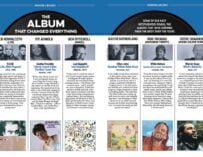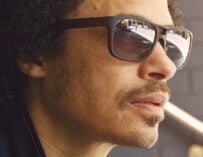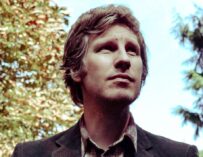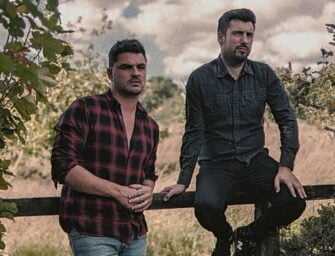25 years after ‘Throwing Copper’ went global, we learn the story of the song that helped it on its way
The post-Nevermind world of the early 90s meant that there was a giant audience hungry for more. Grunge may have been the epicentre of this new guitar-focussed era, but any band with a big enough sound and decent tunes up their sleeves could also feel the ripples of appreciation. One such band was Pennsylvanian alt-rocker, Live, who had been gaining momentum since the release of their debut album, Mental Jewelry, in December 1991.
That momentum carried into the second album, 1994’s Throwing Copper, a US No 1 which has now sold over eight million copies. A large part of the record’s success was down to the song I Alone, which showcased their vast sonic capability as well as the writing chops of lead singer Ed Kowalczyk. Though not officially released in the States, it became a mainstay on rock radio for the remainder of the decade, and beyond, and earned itself the No 60 spot in VH1’s Top 100 Songs Of The 90s.
Here, Kowalczyk talks us through I Alone’s genesis…

Released: 22 May 1994
Artist: Live
Label: Radioactive Records
Songwriters: Chad Gracey, Chad Taylor, Ed Kowalczyk, Patrick Dahlheimer
Producer: Jerry Harrison, Live
UK chart position: 48
US chart position: –
“It was a really exciting time, because sitting there in that barn apartment was an acoustic guitar on which I started to write the chords to I Alone. Knowing that it was going to go into this big open E chorus, I knew what the band could do. Even though I was sitting there with an acoustic guitar, I knew once the band got hold of it they would make the sound as big as the idea. That was a really exciting time for me as a writer because I had this incredible arsenal of a band that was really finding its way.
“I remember sitting there; I came up with the verse but then I wasn’t sure where to go. I really liked that, I thought it was a simple vehicle and I remember thinking that I wanted a minor swell which was almost orchestral and that was where I got the pre-chorus line, ‘To leave you there / by yourself / chained to fate.’ I was still a fledgling as a songwriter, I was still learning, so there’s a spontaneity to what happened between the verse and chorus in that change. It still surprises me that I went for that chord progression. It almost sounds like two songs that are married together by just that transition chord between the verse and chorus. It’s what is so unique about it.
“As we matured and the band got more sophisticated, there comes a desire to want to rediscover the innocence of that period when you were just learning. But you can never get there again – it’s the most frustrating thing. You feel like you may have gotten better but, at the same time, there’s a period in everybody’s life where you’re just in this innocent place of learning something. I can feel that on the whole record but if you take I Alone in particular, I can see that I was there in that place and it was a really special time.

Ed [centre-left] with Live: “I had this incredible arsenal of a band that was really finding its way” Photo: Clay Patrick McBride
“It really is almost two songs: there’s an intimacy and a sort of meditative quality to the lyric of the verses, but then it opens up into something like a love song in the chorus. I didn’t really mean it like that, I wanted the chorus to be a bigger statement about love – universal love – that was more connected to the idea of the verse. I never go into a song with an exact idea of what I want people to think is the meaning, so it’s been wonderful to watch people interpret it in their own ways. As long as they get the emotion, I’m not really that concerned about the meaning. I might have a feeling about what I meant, because I wrote it, but I don’t limit it to that in my mind. Because the song has taken on a timelessness it means it has aged really well and is not stuck to a specific story in history.
“The opening line, ’It’s easier not to be wise,’ was based on me always having had an interest in spiritual traditions and philosophy and finding answers to the big questions in life. That initial lyric is a surrender to the obviousness that it’s easier not to be a wise man. It’s easier to be what we are: fledgling beings trying to find our way through life. It’s a pretty obvious statement but it’s also a kind of surrender, an acknowledgement of our weakness. Then the verses are setting up this meditative place – they even mention a church – just trying to put together an image of a man in contemplation about these bigger ideas. Then it was really a matter of putting these little pieces of meaning together, in almost a montage. Rather than thinking, ‘I’m going to start with this, end here and this is what I mean,’ it’s a piece that comes from a lot of little pieces. I love to work like that and listen to other music that I think is made in that way, because it leaves it wide open to whatever you want to make it.
“I felt like the band understood it right away. It was going to be one of these quiet verses and then explode in the chorus and then we would figure out the stuff in the middle. I had written the verse and the chorus but I didn’t have a middle section, and that’s where Patrick [Dahlheimer] started playing the rumbling bassline. I just came up with the lyric and melody to the bridge live in the studio – the, ‘Oh, now, we took it back too far…’ part – that was the band making it its own. It was a really fun progression to go from me sitting in this barn with an acoustic guitar to what it became in the studio with the band. Now fast forward how many years later and I’m still talking about it – that’s a pretty magical thing.

Live’s Ed Kowalczyk [right]: “It’s a piece that comes from a lot of little pieces.” Photo: Clay Patrick McBride
“I Alone, in particular, was the one that the record company said, ‘This is a hit, this is going to be a song that we are going to get behind and do a video and promote,’ and we all felt that, that the song would be the focal point for the release. Once we had I Alone, I think everyone involved started to get really excited because we had broken into our own sound, sort of by accident, and this song really took it to another level.
“It’s one of those mysterious things. There are songs that you listen to when you have to make an album where you think, ‘This is absolutely going to be the one that everybody will want to hear forever,’ and it ends up not being that song, it ends up being a song you never planned on. I remember reading that happened to R.E.M. a lot, because they were in such a great zone that they would have their favourite song and then the record company would come along and say, ‘Hey, no, it’s this one’. When you’re super-close to it, it’s hard to say what makes it special and I always go back to, ‘Well, if we knew what that was then there’d be a whole lot more of them.’ There’s a mystery to it that I don’t want to mess with.
“I still really love playing I Alone. A lot of that is because we’ve allowed the song to change and grow. We’ve come up with this whole different middle section. It was so wide open, even on the record, that we’ve filled it over time as we were getting better as players and more confident. The song is a perfect template for our band. You can hear the original thrown-down version made by four 23-year-old guys, which is the famous version from the album, then fast-forward all these years to the mature sophisticated band playing it now and it’s still great. It still holds up and we’re still having a lot of fun playing it. It never gets boring.”
The super deluxe anniversary edition of Throwing Copper is out now. For all the latest live dates and information, head to freaks4live.com
Read more ‘How I wrote’ features here > >










![Songwriting Credits… best new music playlist [September 2023]](https://www.songwritingmagazine.co.uk/wp-content/uploads/songwriting-credits-september-2023-335x256.jpg)






























Related Articles